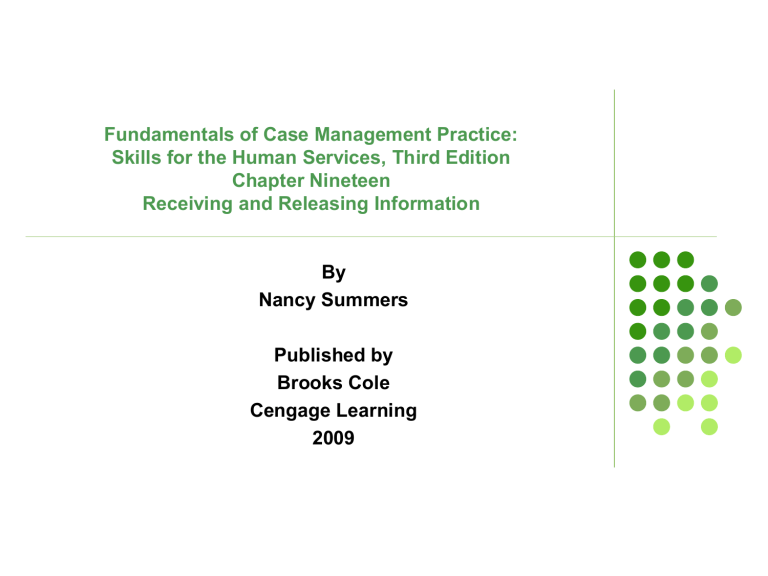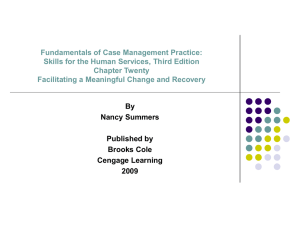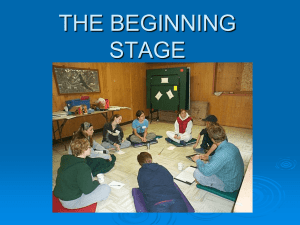Document

Fundamentals of Case Management Practice:
Skills for the Human Services, Third Edition
Chapter Nineteen
Receiving and Releasing Information
By
Nancy Summers
Published by
Brooks Cole
Cengage Learning
2009
Unit 7 Topic is Releasing Information and making meaningful changes.
In this chapter, we will examine:
Receiving and Releasing Information
Facilitating Meaningful Change and
Recovery
Developing a Service Plan
Read Chapter 19, 20, & 21 in your text.
Discussion Board: 2 discussion questions this week.
1.The Recovery Model is a part of a campaign for the Substance Abuse and Mental Health Services Administration in the U.S. Department of Health and Human Services. What is your role in helping the client meet the stages of change?
2.When developing an individualized plan for your client, how will you include the client's strengths, which will be useful in working toward the goals?
Attend Seminar
Project: This week, in a three-page essay, you will write a case management plan for a person.
Project:
Using text, develop an individual plan providing the components that you think will best serve your client.
You will address issues such as what your tentative diagnosis is for the client, whether crisis services are needed and what you would do if they were, what services you need to arrange for the client to help them receive the best care, and your role as the case manager.
You will use critical thinking skills to illustrate the ability to identify the client’s issues; to formulate a logical process of reasoning as to how you have developed the services the client needs, to assess assumptions, and to formulate conclusions based on your own sound reasoning skills.
What is one of the very first thing we do when we meet a new client? Before we start assessing and planning?
SENDING FOR INFORMATION
During the assessment have the client sign the appropriate release forms so that you can obtain information from other agencies relevant to the client’s situation.
Have the client sign the appropriate forms for HIV/AIDS, if your state requires it.
After the interview fax or send the forms to the other agency.
Seek summaries rather than whole records. Whole records are bulky, difficult to store and hard to read through thoroughly.
When seeking medical records it is best to ask for medical records
“pertaining to …..” so that you do not receive the entire record.
RELEASING INFORMATION
Sometimes clients or other agencies seek information from you.
Be sure the forms you receive requesting information are properly signed and dated.
Be sure to follow the state’s guidelines for releasing records containing information on HIV/AIDS.
Make sure the client knows what is being released.
Protect the client from releasing information that might be damaging or have negative consequences for the client.
THE ELEMENTS OF A GOOD RELEASE
FORM
A good release form should have:
The client’s name and date of birth (DOB).
The purpose for the request. Generally the information is requested for the purpose of treatment or service planning.
The date on which the form will expire. The form should not be for longer than 90 days.
A place for witness signatures if the client is unable to write or a minor.
Fundamentals of Case Management Practice:
Skills for the Human Services, Third Edition
Chapter Twenty
Facilitating a Meaningful Change and Recovery
By
Nancy Summers
Published by
Brooks Cole
Cengage Learning
2009
True or False:
We are such good Professionals that we know what is best for our clients and we can make a plan for them on our own?
WORKING TOWARD RECOVERY
Working toward recovery and a positive change involves:
Seeing problems and illness as only a part of who the individual is.
Seeing the client as a competent partner in planning.
Developing a relationship that is trustworthy.
Collaborating on goals that are important to the client.
Giving support and encouragement when needed.
Workers who believe people can change and recover.
Services that the client can use to make changes and sustain them.
DISCOURAGING RECOVERYAND CHANGE
People do not recover or make meaningful changes when workers:
Make decisions with out consulting them.
Set goals without the client’s input.
Demean or denigrate clients.
Act as if clients are incompetent or less capable than they really are.
WHAT IS CHANGE?
Change means different things to different people.
Change usually takes commitment and hard work.
For some change means
Immediate improvements.
Long-term alterations that will have far reaching effects on wellbeing and sense of self worth.
Giving up an old habit.
Accepting a diagnosis.
WHAT KEEPS PEOPLE FROM MAKING
THE CHANGES THEY SAY THEY NEED?
Fear
Uncertainty
Stubbornness
Denial there is a problem or that change is needed
Lack of confidence
Lack of hope
An inability to envision the future after change is accomplished
TEN FUNDMENTAL COMPONENTS OF
RECOVERY
FROM U.S. DEPT OF HEALTH AND HUMAN SERVICES, OFFICE OF SUBSTANCE
ABUSE, AND MENTAL HEALTH SERVICES ADMINISTRATION
Self-Directed The consumer takes the lead.
Empowerment Consumers have authority to choose.
Non-Linear There will be setbacks.
Individualized and Person
Centered Consumers recover using their unique strengths and resources.
Holistic The plan addresses the whole person.
Strengths-based - recovery is built on the person’s strengths.
Peer Support/Mutual
Support - clients encourage each other and provide knowledge to one another.
Responsibility Clients take personal responsibility for their own recovery.
Respect inclusion, full participation, acceptance and appreciation.
Hope the message of a better future.
BEYOND IMMEDIATE PROBLEMS AND
ILLNESS
It is important to help clients plan for the future.
Help client visualize and articulate their goals and ideas for themselves.
Encourage self-determination in where the client would like to go from here.
Collaborate with clients on finding pathways to their goals and ideas.
Consider the physical health of clients and assist clients in obtaining the health care they need, including physicals.
PEER SUPPORT
Peer support is given by peers who have had similar problems and recovered.
Peer support can diminish the sense of being alone for clients.
Peer support counselors often have tips that workers do not have.
DISCOURAGED
When clients are discouraged:
The situation seems to overwhelm them.
They have low regard for their capabilities.
They are unwilling or unable to take responsibility.
They describe their circumstances or other people as totally domineering.
They are unable to focus on solutions.
Their goals seem unrealistic or impossible to them.
They set impossible standards for themselves.
They use global statements, such as “ nobody likes me” or “I never get invited” or “I have no friends”.
HOW CASE MANAGERS MOTIVATE AND
ENCOURAGE
Begin where the client is - Use reflective listening to listen to where the client is now before going for solutions.
See the client’s strengths clients have strengths and capabilities that will help them change.
Accurately assess the client’s ambivalence Not all reluctance to follow through is resistance. The client may be afraid or overwhelmed.
Appreciate every effort When working toward changes some efforts may fail. Appreciate the effort.
Never lose sight of potential focus on what clients can do and talk about past accomplishments and experiences
STAGES OF CHANGE
Stage One: Precontemplation The client is not ready for change and probably not even thinking about it.
Stage Two: Contemplation The client is ready to explore change but not ready to commit to it.
Stage Three: Developing a Plan The client is ready to change but needs a plan
Stage Four: Implementing the Plan the client may be uncertain but will actually change her habits, behaviors, or thinking.
Stage Five: Maintaining Changes The client wants the changes to be permanent. Sometimes there are still obstacles.
Relapse the client is unable to sustain the change over a long period of time and may return to the old ways.
AMBIVALENCE AND RELUCTANCE
People move toward recovery at different rates.
Some people are more ambivalent about changing than others.
Ambivalence and reluctance are a normal part of changing.
Case managers need to accept the ambivalence and reluctance as a normal part of moving toward change and recovery.
Some people stay with their ambivalence longer than others and some people never move beyond it.
ROLLING WITH RESISTANCE
We sometimes view reluctance and ambivalence as resistant.
There may be other reasons a person is not moving quickly
You may hear excuses or the person may ignore the plan you constructed together. The client may avoid you or procrastinate.
We should see resistance as a signal to do things differently.
Resistance tells us that what we have constructed and the support we are giving for change needs to be done differently.
Respect where the client is and make it clear that:
1. You want to listen
2. The decision is theirs
3. Ambivalence about change is normal
Fundamentals of Case Management Practice:
Skills for the Human Services, Third Edition
Chapter Twenty-one
Developing a Service Plan at the Case Management Unit
By
Nancy Summers
Published by
Brooks Cole
Cengage Learning
2009
THE SERVICE PLAN
You, as a case manager, do not give the actual service or treatment.
Service or treatment is given at a provider agency.
You develop the general goals the provider agency is to address.
Some goals are treatment goals: treatment for mental illness, drug or alcohol abuse, emotional problems.
Some goals will be service goals: welfare assistance, in-home care, transportation, educational and occupational goals.
The goals are general. They do not tell the provider agency how to address them.
A good service or treatment plan should identify goals and employ clients’ strengths to meet those goals.
INVOLVING THE CLIENT AND THE FAMILY
Clients and their families (if the client gives permission) should participate in developing a plan for the client.
With children families should always be involved.
With substance abuse family participation can keep families together.
It is important to listen to what the client wants as a result of services from your agency.
Agency support for families to stay involved with clients is important in many cases.
USING THE ASSESSMENT
The evaluation or social history tells you what clients’ major problems are and what areas of their lives need attention.
The assessment should include clients’ expectations and desires.
IDENTIFYING CLIENTS’ STRENGTHS
In looking for clients’ strengths and resources look at:
Community supports: churches, clubs, the school.
Religious and cultural beliefs, practices and values that are supportive and comforting.
Interpersonal skills.
Special abilities and skills.
What the person would choose to do as a preference. Use this particularly with children.
Activities done with the entire family.
Hobbies, recreational activities.
People, groups, or pets that give the client support and comfort.
INDIVIDUALIZED PLANNING
Case managers develop plans for their clients that are specific to a particular client
No two plans should be exactly alike
Self- awareness should help case managers to know when they are treating all people in a certain category alike. For example, all older people, young girls, mothers and so forth.
What are some of the Barriers to understanding our Clients?
BARRIERS TO UNDERSTANDING
Language: The client may not be able to communicate adequately with others because of a difference in primary language. The worker may not be able to communicate with the client because the worker does not speak the client’s language.
Culture: The client may be unable to negotiate an unfamiliar culture. The worker may not understand the client’s culture or may be inclined to judge the client’s culture by the worker’s own cultural standards.
Disability: The client may not be able to handle all the details of the plan.
The worker may overestimate or underestimate the extent of the client’s disability.
Lack of resources: The client may lack the resources to fully participate in the plan
(e.g., transportation or clothing suitable for a job interview). The worker may see the client’s poverty as a barrier to the plan or fail to take the lack of resources into account.
Mental illness: The client may be unable to communicate clearly or follow through with the plan. The worker may be afraid of the illness or may fail to understand how the illness affects the client’s capabilities.
Mental retardation: The client may be unable to communicate clearly or follow through with the plan. The worker may see the client as a child or may fail to understand how the disability affects the client’s capabilities.






